By Jaimy Szymanski, Jeremiah Owyang, Jessica Groopman, and Rebecca Lieb of Kaleido Insights.
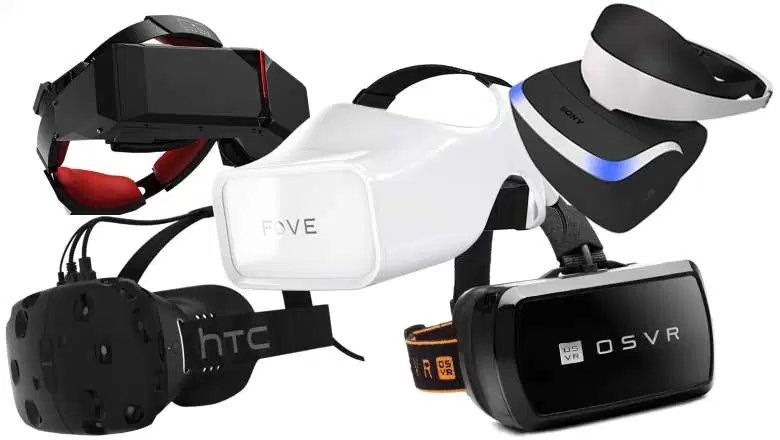
As VR/AR/MR make their way into the corporate ecosystem, positive impacts and operational efficiencies abound. From sales and service; to HR, safety, and training; to engineering and product development, teams feel their wake and harness the power of informational overlay.
Kaleido Insights’ methodology for analyzing emerging technology assesses the impacts on humans, on businesses, and on the ecosystem. As part of our ongoing coverage, we’ll be covering a series of topics using our methodology to help business leaders first understand, and then see beyond the bright and shiny and cut right to what matters.
In each post, all Kaleido Insights analysts conduct a joint analysis session around one topic (e.g. technology, event, announcement, etc.). In this post, we analyze the business and organizational impacts of virtual, augmented, and mixed reality.
Topic: VR/AR/MR
Examples:
Oculus Rift; HTC Vive, Playstation VR, Google Cardboard, Microsoft Hololens, Samsung Gear VR, other plug-and-play smartphone options
Impact Analysis: Organizations & Business
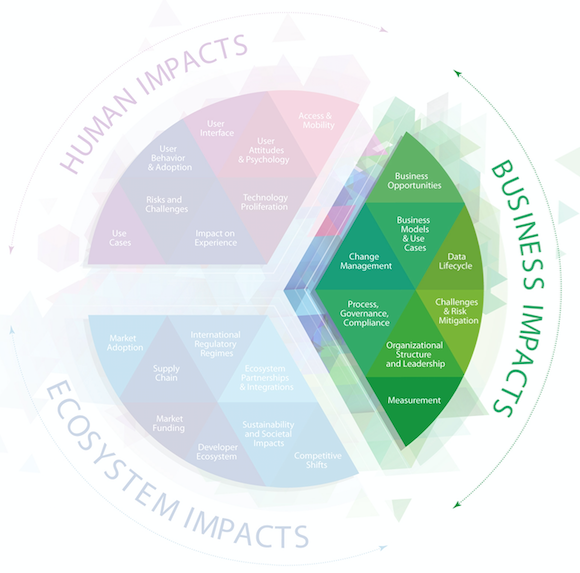
Business Opportunities and Use Cases
As VR/AR/MR have permeated business environments, leaders are recognizing that opportunities reach beyond video gaming and novelty. VR/AR/MR have a place in every industry, with multiple use cases. Many of these use cases require interoperability with other technologies to reach full potential, including artificial intelligence (AI), computer vision, wearables, drones, 3D-printing, facial recognition, and more.
- Immersive training and education. Organizations have the opportunity to use VR to train employees – either onsite or remotely – in virtual, simulated worksite environments. Consider options in scaling complex equipment, repair, or other training programs to multiple employees at various locations. EON Reality is experimenting with Chick-fil-A on a training program that immerses potential employees in a restaurant kitchen to train in a virtual environment. VR training is also effective in immersing trainees in high-pressure or otherwise dangerous scenarios. There are AR/MR education opportunities to train employees on-the-job using visual informational overlay via augmented reality glasses or similar technologies. This effectively brings a catalog of contextual product and merchandising data to the forefront of employee access. There are numerous examples of surgeons and doctors using VR and AR for complex surgical training.
- Skills, Operating, and Repair Guidance. Augmented and mixed reality shine in their facilitation of efficient employee guidance while performing difficult or heavily information-dependent skills, operating machinery, or repairing equipment. Viewed as a visual overlay to the real world via AR glasses or specialty headsets, mobile phones, or tablets, AR expands information about physical equipment that is useful to employees. This may include procedural directions, machine models, serial numbers, repair parts, operating manuals, and more. For example, Caterpillartechnicians are outfitted with Hololens and AR-equipped tablets (see image below) to provide informational overlays to increase repair efficiency and accuracy.
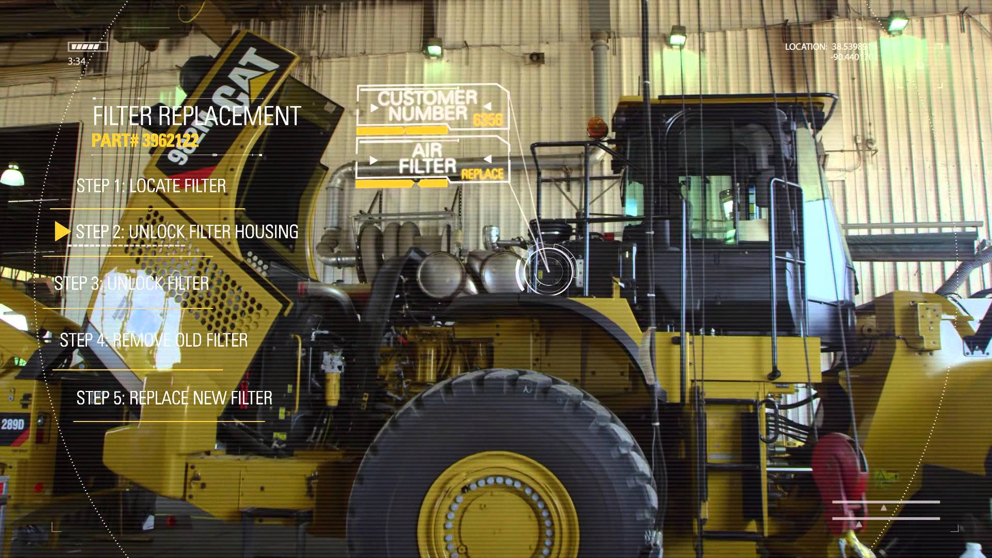
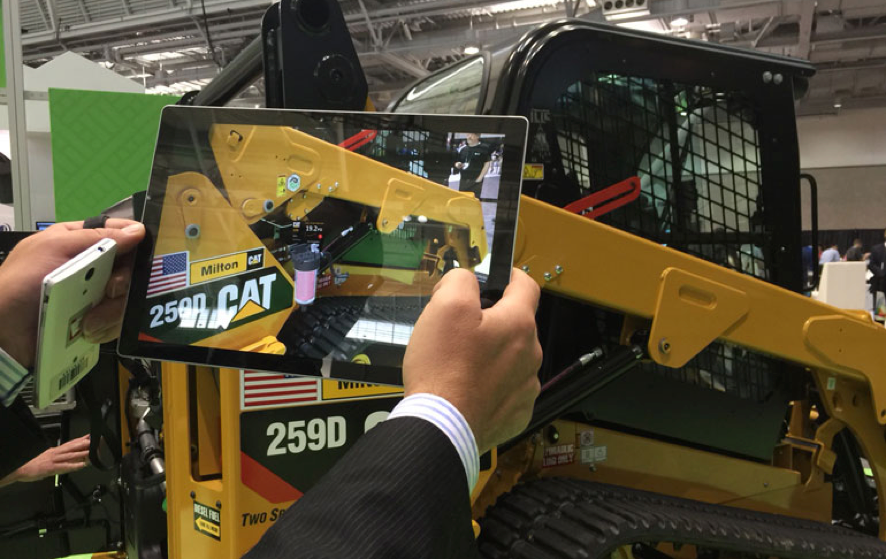
Image Sources: Caterpillar Inc.’s YouTube Video, “Augmented Reality Brings Data to Life at Caterpillar” and the Internet of Things (IoT) Institute
- Engineering Planning and Product Development. VR gives organizations the opportunity to understand products, parts, and machinery before they hit production. By creating 3D models that can be explored via virtual reality software and hardware, engineers are able to better predict potential design issues, collisions among other parts or equipment, plan for ergonomics of employee operations, and steer clear of potential safety concerns. Using VR, manufacturing design and engineering transforms from reactive to proactive, allowing for entire teams to easily weigh in on the process before any real-world applications are implemented.
- Sales and Marketing Engagement. Virtual reality can also be used as both a technical sales and consumer sales tool. In industrial capacities, VR offers the ability to view intricacies of machinery, parts, or tooling before a purchase order is signed. This builds bridges between those designing the technologies and equipment with less technical buyers. By creating proofs-of-concept in VR, sales prospects are immersed and influenced in a deeper way during design reviews. Looking toward consumer focused AR, retailers like Uniqlo (see image below) are experimenting with virtual dressing rooms, allowing customers to “try on” clothing without ever disrobing, and Ikea is well-known for its AR app that places furniture into the homes of its customers. Imagine the opportunity for a service like StitchFix to create a virtual stylist environment for customers to access their monthly shipments and try them on (with potential for upselling) before the physical clothing is even sent.
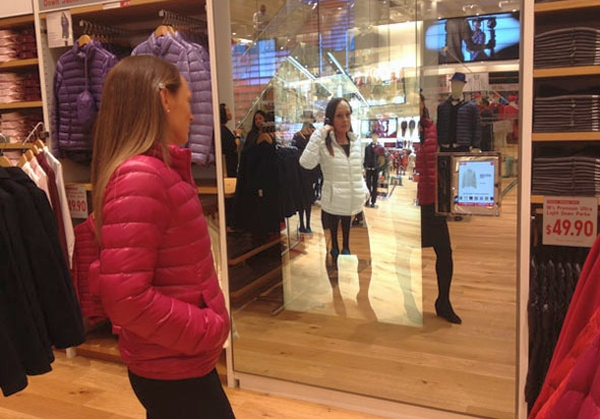
Above image: Uniqlo’s “Magic Mirror” augmented reality experience
- Immersive Storytelling. From the New York Times, to Charity Water, to Save the Children International, VR has been used to tell more gripping and emotional stories in immersive environments. VR/AR/MR are growing in organizational content marketing strategies as another channel to voice brand promise, promote new products and services, and raise awareness for causes. These technologies are also being used to augment tourist experiences in new ways, as Disney World is readying a Star Wars VR experience to launch next year.
Business Models
We’ll see VR/AR/MR enhancing existing business models via enabling new revenue streams in new channels. There are also significant opportunities to achieve cost savings in maintenance, repair, and design. There may also be business model potential in creating goods in virtual or augmented environments and either a. ordering them for real-world shipment or b. 3D-printing them at home. New communications models are already emerging to meet friends in virtual reality spaces, as is possible in “Rec Room” on the Steam network for HTC Vive. Look for new opportunities to emerge in the travel space as well, when VR users can virtually visit exotic locations for a price.
Organizational Structure and Leadership
VR/AR/MR pushes the internal departmental boundaries at organizations that are not equipped to rapidly innovate and harness the power of disruptive technologies. The lines will continue to blur between digital, marketing, IT, and innovation groups as a greater focus on CX and EX (employee experience) rises from new VR/AR/MR implementations. The rise of the “Innovation Center of Excellence” gives way to quicker VR/AR/MR initiative development when multiple business units are working in synchronicity. The first department to deploy VR/AR/MR will depend on its use case (e.g. if it’s consumer-focused, it will likely be marketing, whereas if it’s training focus it may sprout from a partnership between IT and HR).
Change Management
As with any disruptive technology, expect push-back from older generations or late adopters who have not yet found a valuable use case for VR/AR/MR in their lifestyle or career. These technologies begin to (or, fully, in some cases) replace human-to-human, real-world interactions, as well as require new user skillsets, which can be difficult for employees to embrace. In corporate environments, utilizing training and education programs around on-the-job VR/AR/MR use cases that make work easier, more efficient, or save money can be an effective foray into catalyzing change management and helping ease employees into their use.
Another popular challenge related to change management is that VR/AR/MR technology is initially viewed as a novelty. Companies may receive mixed reception from customers and prospects as to the viability of VR/AR as an engineering/design/sales tool. They’re intrigued by the possibility, but not convinced of its value or capabilities. Only through assigning measurable objectives, regular experimentation, learning, and failing fast, can organizations quickly prove its value.
Data Lifecycle
In the world of relatively nascent VR, the provider with the most content ultimately wins. This reward typically falls to one in the headset monopoly of Oculus Rift, HTC Vive and Playstation VR (of which, Vive sees greatest developer popularity). Consumers choose the headset that offers the content they desire, and companies follow suit in the “what can you do for my use case?” mindset. AR/MR are broader and more accessible across devices, as the associated hardware is most often a mobile phone. Apple’s AR Kit has also democratized development with its accessibility and ease of use.
Process, Governance, Compliance
Internal process and governance around VR/AR/MR initiatives will depend on the use cases established. In terms of compliance, we foresee the biggest hurdle being consent in regard to AR/MR, especially on a global scale where protecting individual privacy and identity can be paramount to a country’s culture. When anyone can use AR/MR facial recognition features, or overlay data on their environment, compliance is difficult to enforce at every level of consumer, employee, and ecosystem interaction.
Measurement
Specific metrics attached to VR/AR/MR are dependent on the business use case established for the technology within an organization. Sample metrics may include:
- Decrease in accidents on trained scenarios
- More efficient repairs and installations
- Reduced maintenance costs and shop-floor collisions
- Reduced rework on jobs over time
- Increased profitability on programming tools and fixtures
- More efficient use of time on redesigns (less total redesigns)
- More efficient troubleshooting
- More complete design back-ups
- Increased sales and more satisfied customers due to involvement in VR process
Challenges & Risk Mitigation
Companies misunderstand technology needs and costs associated with virtual reality. Even if starting small and understanding minimum technology requirements, bringing VR/AR/MR into a facility requires costs in hardware (both computers that can handle the necessary operating load and the actual hardware headsets, glasses, immersive cubes, screen panels, etc.), as well as software. Finally, virtual reality presents new challenges to content marketers who are not accustomed to non-linear storytelling that requires multiple scenarios vs. a start-to-finish script. Machine and deep learning will prove to be continually useful in helping generate infinite scenarios in immersive storytelling.
This is just one of the myriad technologies creating new uses cases for business and consumer adoption and value. And, these are just a few of the many impacts on organizations today. Kaleido Insights’ analysts are tracking these and other technologies closely to help you find clarity amidst the chaos. Interested in discussing the impacts of VR/AR/MR – to your customers, business, or ecosystem? Our industry analyst Jaimy Szymanski is looking for interview participants for an upcoming report on VR/AR/MR enabling the “super employee” experience. Contact her here, or reach out via Twitter.
Really so nice tools for us and every people are have more interest about this. So i hope most of the users are be happy to get such kind of technology.